

Current degree day accumulations
Orchard radar apple insect key dates
Location: UMass Cold Spring Orchard, Belchertown, MA
20-May, 2013 |
|
| Base 43 | 490 |
| Base 50 | 296 |
| Coming events | Degree days (Base 43) |
| Green fruitworm flight subsides | 251-451 |
| Spotted tentiform leafminer sap feeders present | 343-601 |
| Oriental fruit moth 1st flight peak | 347-547 |
| Lesser apple worm 1st catch | 363-561 |
| San Jose scale 1st catch | 430-614 |
| San Jose scale 1st flight peak | 554-746 |
| Codling moth 1st flight peak | 57-999 |
| European red mite 1st summer eggs | 447-555 |
| Lesser peachtree borer 1st catch | 485-683 |
| Oblique-banded leafroller pupae present | 601-821 |
| Plum curculio oviposition scars present | 485-589 |
| McIntosh fruit set | 510-600 |
Beginning this week, I will summarize the key insect dates from Orchard Radar, Belchertown, MA.
Codling moth (CM) 1st generation, first sustained trap catch biofix date: May 16, Thursday. Codling moth development as of May 20: 1st generation adult emergence at 2% and 1st generation egg hatch at 0%. In most orchards, insecticide targetted against plum curculio and apple maggot prevent codling moth damage.
Obliquebanded Leafroller (OBLR) 1st generation OBLR flight begins around: June 7, Friday. Where waiting to sample late instar OBLR larvae is not an option (= where OBLR is known to be a problem, and will be managed with insecticide against young larvae): Early egg hatch and optimum date for initial application of B.t., Delegate, Proclaim, Intrepid, Rimon, Altacor, Belt, pyrethroid or other insecticide effective against OBLR (with follow-up applications as needed): June 24, Monday.
Oriental Fruit Moth (OFM) 1st generation OFM flight starts: May 3, Friday. 1st generation 55% egg hatch and first treatment date, if needed: May 28, Tuesday.
Plum curculio (PC) increased risk of PC damage as McIntosh and similar cultivars increase fruit size: May 20, Monday. Earliest safe date for last PC insecticide spray: May 28, Tuesday. If relying on repellance by Surround instead of PC mortality by insecticide, Surround coverage should be maintained until PC egglaying begins to naturally decline around Wednesday, June 26.
Spotted Tentiform Leafminer (STLM) 1st generation sapfeeding mines start showing: May 20, Monday. Optimum sample date is around Tuesday, May 21, when a larger portion of the mines are visible.
European Red Mite (ERM) Optimum monitoring period for 1st generation ERM: Wednesday, May 15 (Petal Fall) to Thursday, May 23 (early adults ready to lay eggs for 2nd generation)
http://extension.umass.edu/fruitadvisor/upcoming-events
It's a period of high activity -- disease pressure is very high, I assume every apple orchard is well protected with fungicide and strep as necessary -- and plum curculio are active. In addition, it's time to apply thinning sprays. Need I say more? Oh yea, the grass is growing like crazy too and codling moth are hatching and it's time to treat for spotted tentiform leafminer (as necessary, after you have scouted for mines), etc., etc.
If you are finished spraying and need to get away for an evening, consider going to the premier of Vanishing Orchards: Apple Growing In Rhode Island at the Jane Pickens Theater in Newport, RI on Thursday, May 23.
First codling moth (CM) trap catch (picture) at the UMass Orchard late last week. Below is the current NEWA output on CM management. In general, petal fall sprays for plum curculio CM. See the 2012 New England Tree Fruit Management Guide for specific recommendations.
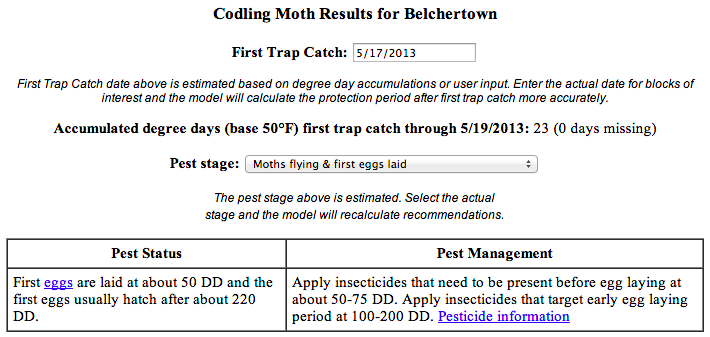
Plum curculio (PC) will be active this week. Below is the NEWA status. Needless to say, some insecticide coverage is necessary beginning at petal fall until the risk of damage is over (at about 340 DD's).
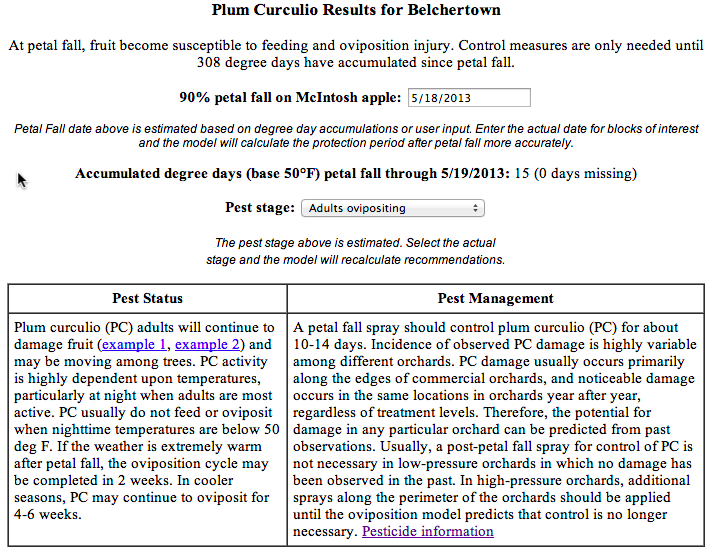
Petal fall sprays also control oblique-banded leafroller OBLR (to a certain extent). Below is the current NEWA output and discussion fro OBLR.
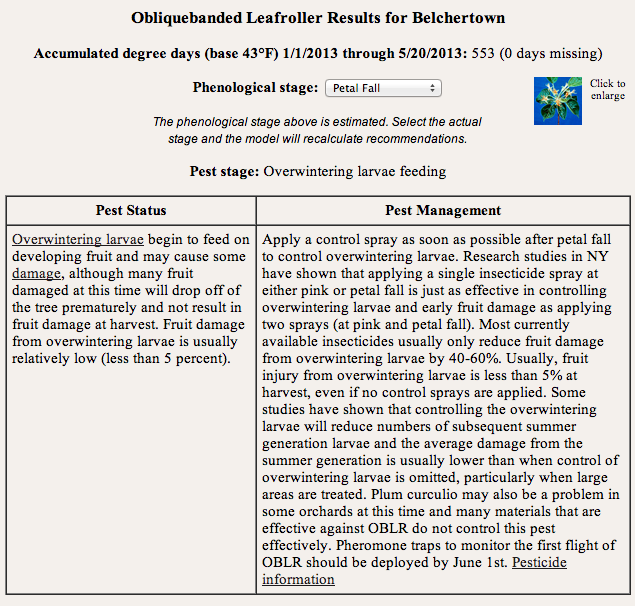
Risk of apple scab, rust, and fire blight infection is HIGH this week. Here is an e-mail from Dan Cooley:
"High Risk of Scab and Fire Blight This Week"
Over this coming week, conditions for a heavy apple scab infection may develop. There is a large amount of scab inoculum available for release, and if rain develops and keeps leaves wet over the next few days, it will result in a heavy scab infection. Application of protectant fungicides combined with a DMI, strobilurin, or SDHI fungicide prior to infections. Showers may make it difficult to apply fungicides, but it will be well worth putting on an application sooner rather than later.
Please note there's an error in the New England Tree Fruit Management Guide. The Inspire Super rate is listed as 8 oz/A. This is below the range from trials, which is 8.5 to 12 oz/A, and well below the current label rate of 12 oz/A. Given the potential severity of apple scab infections occurring as a result of the present rain, growers should use the 12 oz/A rate. And as always, mix any SI including Inspire Super with a contact fungicide, mancozeb (3 lb/A), or captan (80WP at 2 lb/A).
In addition, models are predicting a high risk of fire blight, particularly at the end of next week. In those trees that still have blooms, a streptomycin application should be considered, at least in highly susceptible varieties or where there is a history of fire blight.
Again, I want to point out that the Apple Carbohydrate Thinning Model is now available on NEWA: http://newa.cornell.edu/index.php?page=apple-thin. Below is the current output for Belchertown.
I have access to three different thinning models, and all suggest moderate thinning activity this week. That means the trees are pre-disposed to good chemical thinning, largely on account of warm, cloudy weather. Of course the models are very weather-dependent, and the forecast may change. BUT, expect good petal fall thinning activity if you apply a thinner early-mid week this week. The models suggest with a return to fair and cooler weather late week and next weekend, then the trees will be harder to thin with chemical thinners. Adjust your chemical thinner rates accordingly.
Here is a good short article from MSU on 'Apple Thinning Pointers for 2013.' It is aimed at Michigan growers, but most points are appropriate for us here in Massachusetts.
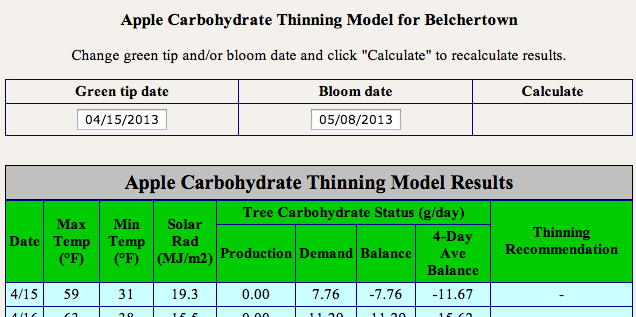
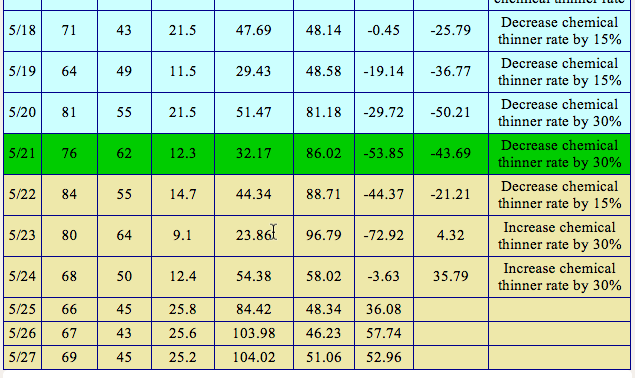
UMass Fruit Advisor: http://umassfruit.com
Scaffolds Fruit Journal: http://www.nysaes.cornell.edu/ent/scafolds/
Network for Environment and Weather Applications (NEWA): http://newa.cornell.edu
Follow me on Twitter (http://twitter.com/jmcextman) and Facebook (http://www.facebook.com/jmcextman)
UMass Vegetable & Fruit IPM Network (on Facebook, http://www.facebook.com/umassipmteam)
The next Healthy Fruit will be published on Tuesday, May 28 or thereabouts, 2013. As always feel free to get in touch with any member of the UMass Fruit Team (http://extension.umass.edu/fruitadvisor/team-members) if you have questions or comments.